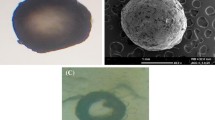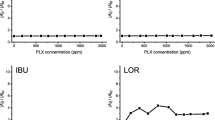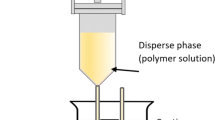Abstract
The present work investigated the release of Flurbiprofen (FLU) from Eudragit RS100® (RS) and Eudragit RL100® (RL) nanosuspensions to a biological model membrane consisting of Dimyristoylphosphatidylcholine (DMPC) multilamellar vesicles (MLV). This release was compared with those observed from solid drug particles as well as with dialysis experiments. Nanosuspensions were prepared by a modification of Quasi-Emulsion Solvent Diffusion technique. Drug release was monitored by the Differential Scanning Calorimetry (DSC). FLU dispersed in MLV affects the transition temperature (Tm) of DMPC liposomes, causing a shift towards lower values. The temperature shift is modulated by the drug fraction present in the aqueous lipid bilayer suspension. DSC was also performed, after increasing incubation periods at 37°C, on suspensions of blank liposomes added to fixed amounts of unloaded and FLU-loaded nanosuspensions, as well as to powdered free drug. Tm shifts, caused by the drug released from the polymeric system or by free-drug dissolution during incubation cycles, were compared with those caused by free drug increasing molar fractions dispersed directly in the membrane during their preparation. These results were compared with the drug release and were followed by a classical dialysis technique. Comparing the suitability of the 2 different techniques in order to follow the drug release as well as the differences between the 2 RL and RS polymer systems, it is possible to confirm the efficacy of DSC in studying the release from polymeric nanoparticulate systems compared with the “classical” release test by dialysis. The different rate of kinetic release could be due to void liposomes, which represent a better uptaking system than aqueous solution in dialysis experiments.
Similar content being viewed by others
References
David S, Illum L, McVie JG, Tomlison E. Microspheres and Drug Therapy. Amsterdam, Netherlands: Elsevier; 1984.
Bakan JA, Powell TC, Szotak PS. Recent advances in microencapsulation of drugs to obtain reduced gastric irritation. In: Donbrow M, ed. Microcapsules and Nanoparticles in Medicine Pharmacy. Boca Raton, FL: CRC Press; 1991:183–192.
Kawata M, Nakamura M, Goto T, Ayoama T. Preparation and dissolution pattern of Eudragit RS microcapsules containing Ketoprofen. Chem Pharm Bull. 1968;34: 2618–2623.
Goto S, Kawata M, Makamura M, Maekauwa K, Ayoama T. Eudragit RS and RL (acrylic resins) micro-capsules as pH insensitive and sustained release preparations of ketoprofen. J Microencapsulation. 1986;3:293–304.
Kawashima Y, Niwa T, Handa T, Takeuchi H, Iwamoto T, Ito Y. Preparation of prolonged-release spherical micromatrix of ibuprofen with acrylic polymer by the emulsion solvent diffusion method for improving bioavailability. Chem Pharm Bull. 1989;37:425–429.
Kawashima Y, Niwa T, Handa T, Takeuchi H, Ito Y. Preparation and characterization of a new controlled release ibuprofen suspension for improving suspendability. Int J Pharm. 1991;75:25–36.
Kawashima Y, Toshiyuki H, Takeuchi H, Hino T, Ito Y. Control of prolonged drug release and compression properties of ibuprofen microsponges with acrylic polymer; Eudragit RS, changing their intrapartical porosity. Chem Pharm Bull. 1992;40:196–201.
Pignatello R, Vandelli MA, Giunchedi P, Puglisi G. Properties of Tolmetin-loaded Eudragit RL100 and RS100 microparticles prepared by different techniques. STP Pharma Sci. 1997;7:148–157.
Khalil E, Sallam A. Interaction of two Diclofenac acid salts with copolymers of ammoniomethacrylate: effect of additives and release profiles. Drug Dev Ind Pharmacy. 1999;25:419–427.
Thaller VT, Kulshrestha MK, Bell K. The effect of pre-operative topical Flurbiprofen or Diclofenac on pupil dilatation. Eye. 2000;14:642–645.
Seydel JK. Nuclear magnetic resonance and differential scanning calorimetry as tools for studying drug-membrane interactions. Trends Pharmacol Sci. 1991;12:368–371.
Duzgunes N, Wilschut J, Papahadjopoulos D. Control of membrane fusion by divalent cations, phospholipid headgroups and proteins. In: Conti F, Blumberg WE, De Gier J, Pocciari F, eds. Physical Methods on Biological Membranes and their Model Systems. New York, NY: Plenum Press; 1985:193–218.
Houslay MD, Stanley KK. Mobility of the lipid and protein components of biological membranes. In: Dynamics of Biological Membranes. New York, NY: Wiley and Sons; 1983:40–91.
Tenchov B. On the reversibility of the phase transitions in lipid-water systems. Chem Phys Lipids. 1991;57:165–177.
Marsh D. Physical characterization of liposomes for understanding structure-function relationships in biological membranes. In: Barenholzand Y, Lasic DD, eds. Nonmedical Applications of Liposomes. Boca Raton, FL. CRC Press; 1996:1–16.
Mabrey-Gaud S. Differential scanning calorimetry of liposomes. In: Knight CG, ed. Liposomes: From Physical Structure to Therapeutic Applications. Amsterdam, The Netherlands: Elsevier/North-Holland Biomedical Press; 1981:105–138.
Bach D. Calorimetric studies of model and natural biomembranes. In: Chapman D, ed. Biomembrane Structure and Function. London, England: MacMillan Press; 1984:1–41.
Silvius JR. Thermotropic properties of phospholipid analogues. Chem Phys Lipids. 1991;57:241–252.
Jain MK, Wu NM. Effect of small molecules on the Dipalmitoyllecithin liposomial bilayer: III Phase transition in lipid bilayer J Membrane Biol. 1977;34:151–201.
Jain MK. Order and dynamics in bilayers. In: Jain MK, ed. Introduction to biological membranes. New York, NY: Wiley and Sons; 1988:122–165.
Castelli F, Puglisi G, Pignatello R, Gurrieri S. Calorimetric studies of the interaction of 4-Biphenylacetic acid and its β inclusion compound with lipid model membrane. Int J Pharm. 1989;52:115–121.
Lohner K. Effects of small organic molecules on phospholipid phase transitions. Chem Phys Lipids. 1991;57:341–362.
Raudino A, Castelli F. Modeling specific heat transient anomalies during permeation of liposomes by water-soluble substances. J Coll Interf Sci 1998;200:52–58.
Castelli F, Conti B, Puglisi G, Conte U. Effect of molecular weight and storage times on Tolmetin release from poly-D,L-lactide microspheres to lipid model membrane: a calorimetric study. J Controlled Rel. 1996;40:277–284.
Castelli F, Pitarresi G, Tomarchio V, Giammona G. Effect of pH on the transfer kinetics of an anti-inflammatory drug from polyaspartamide hydrogels to lipid model membrane. J Controlled Rel. 1997;45:103–111.
Castelli F, Uccella N, Saija A, Trombetta D. Differences between Coumaric and Cinnamic acids in membrane permeation as evidenced by time-dependent calorimetry. J Agr Food Chem. 1999;47:991–995.
Castelli F, Pitarresi G, Giammona G. Influence of different parameters on drug release from hydrogel systems to biomembrane model: evaluation by differential scanning calorimetry technique. Biomaterials. 2000;21:821–833.
Pignatello R, Spedalieri G, Bucolo C, Maltese A, Puglisi G. Flurbiprofen-loaded acrylate polymer nanosuspensions for ophthalmic application. Biomaterials. 2002;15:3247–3255.
Rouser G, Fleischer S, Yamamoto A. Two-dimensional thin-layer chromatographic separation of polar lipids and determination of phospholipids by phosphorous analysis of spots. Lipids. 1970;5:494–496.
Jorgensen K, Ipsen JH, Mouritsen OG, Bennet D, Zuckermann MJ. The effects of density fluctuations on the partitioning of foreign molecules into bilayers: application to anaesthetics and insecticides. Biochim Biophys Acta. 1991;1062:227–238.
Cevc G, Marsh D. Cell biology: a series of monographs, vol 5: phospholipid bilayers: physical principles and models, In: Bittar EE, ed. Phospholipid Bilayers Physical Principles and Models. New York, NY: Wiley; New York, 1987:1–441.
Pignatello R, Amico D, Chiechio S, Spadaro C, Giunchedi P, Puglisi G. Preparation and analgesic activity of Eudragit RS100® microparticles containing Diflunisal, Drug Delivery. 2001;8:35–45.
Jenquin MR, McGinity JW. Characterization of acrylic resin matrix films and mechanisms of drugpolymer interactions. Int J Pharm. 1994;10:23–34.
Pignatello R, Ferro M, Puglisi G. Preparation of solid dispersions of non-steroidal anti-inflammatory drugs with acrylic polymers and studies on mechanisms of drug-polymer interactions. PharmSciTech. In press.
Jenquin MR, Liebowitz SM, Sarabia RE, McGinity JW. Physical and chemical factors influencing the release of drugs from acrylic resins films. J Pharm Sci. 1990;79:811–816.
Castelli F, Messina C, Pignatello R, Puglisi G. Effect of pH on diclofenac release from Eudragit RS100® microparticles: a kinetic study by DSC. Drug Delivery. 2001;8:173–177.
Author information
Authors and Affiliations
Corresponding author
Rights and permissions
About this article
Cite this article
Castelli, F., Messina, C., Sarpietro, M.G. et al. Flurbiprofen release from eudragit RS and RL aqueous nanosuspensions: a kinetic study by DSC and dialysis experiments. AAPS PharmSciTech 3, 9 (2002). https://doi.org/10.1208/pt030209
Received:
Accepted:
DOI: https://doi.org/10.1208/pt030209




